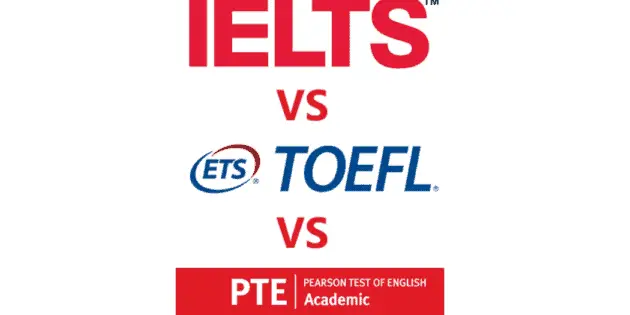PTE, IELTS, TOEFL – All these different acronyms can seem very confusing at first. However, they are simply acronyms for different English language tests that universities and immigration departments often require you to take to prove your level of English. The main differences between the three are as follows:
IELTS and TOEFL are the most established tests accepted by 99% of universities and immigration depts worldwide. The PTE is less well known and not accepted as widely. To assess candidates, PTE uses AI 100%, TOEFL uses human raters and AI, and IELTS includes a face to face interview and standardized testing methods.
There are a few key factors to consider when deciding which of these to take, including: if they are accepted by the university or immigration department you are dealing with, how quickly you need the results, and what particular types of test questions you are good at in English. Let’s take a closer look at these issues.
What Are The Differences Between PTE, IELTS and TOEFL?
Feature | PTE | IELTS | TOEFL |
Test variations: | PTE Home (A1-B1) PTE General PTE Academic PTE Academic UKVI | IELTS General IELTS Academic IELTS UKVI Academic IELTS UKVI General | TOEFL iBT Home Edition TOEFL iBT (Academic) TOEFL Essentials (General) |
Owned by: | Pearson PLC, UK based. | British Council, IDP Australia, Cambridge English. | Educational Testing Service (ETS), US based. |
More commonly preferred in: | PTE Academic is approved for all UK, Australian and New Zealand student visas. PTE is accepted in around half of US universities and nearly all UK and Australian unis. | Great Britain, Australia, New Zealand, Canada and Europe. IELTS UKVI is requried for UK visas. IELTS is accepted by US universities. | USA. Accepted by all UK universities. Accepted for the English-language requirement of UK student route visas. |
Speed of results: | Available within 48 hours. | Paper based IELTS takes 13 days. Computer based IELTS 3-5 days. | Approximately 6 days after your test. |
Coverage: | Over 250 Pearson test centres in 178 countries. | 1,200 centres across 140 countries | 45,000 centres across 150 countries |
Retest policy: | Schedule tests up to 24 hours in advance, 365 days a year. | Unlimited | As many times as you want but not within 3 days |
Method of delivery: | Computer delivered at a Pearson test centre | Computer delivered (CD IELTS) or paper based IELTS taken at a BC or IDP test centre. | Internet based (iBT) or paper based (PBT) at a test centre, home based test also possible. |
Cost of test in the US: | PTE Academic $235 (significant price differences per country) | $245 – $255 | $180 – $190 |
Maximum possible score: | 90 points | Band 9 | 120 points |
How test is scored: | Overall score is based on a communicative skills (reading, writing, listening, speaking) score and an enabling skills score (grammar, spelling vocab etc). | Individual band scores for each skill: reading, writing, listening and speaking are equally weighted and averaged to give an overall band score. | 30 points each for reading writing listening and speaking totalled. |
Listening format: | 8 sections, 45 – 60 mins. | 4 sections of 10 qus, 30 - 40 mins. Question types: multiple choice, matching, plan/map/diagram labeling, form/note/table/flow chart/summary completion, sentence completion, short-answer questions. | 5-7 sections, 28-39 ques total, 41 - 57 mins total. multiple choice, choose multiple, or single answers, and complete a table. |
Reading format: | 5 sections, 32-40 mins. Question types: Multiple choice, choose multiple answers, re-order paragraphs, reading: fill in the blanks, multiple choice, choose single answer. | 3 sections, 40 qus, 60 mins. Question types: matching, labeling, gap fill, sentence completion, form completion etc... | 3-4 sections, 30 qus, 54-72 mins. Question types: Multiple choice only |
Reading text types: | Standard education type articles | General: notices, ads, company handbooks, books, magazines and newspapers. Academic: journals, magazines, books, and newspapers | Academic texts only |
Speaking format: | 6 sections, 47-63 mins, answers recorded. Part 1: Personal introduction Part 2: Read aloud Part 3: Repeat sentence Part 4: Describe image Part 5: Re-tell lecture Part 6: Answer short question | 3 sections, 11-14 minutes face to face with examiner. Part 1: short everyday life questions. Part 2: speak about a given topic for 2 mins. Part 3: discussion with examiner. | 4 sections, 17 minutes, answers recorded. Part 1: Independent speaking Part 2-4: Integrated skills tasks |
Writing speed: | 300 words in 30 mins | 400 words in 60 mins | 500 words in 50 mins |
Writing format: | Summarize a 300 word written text in one sentence, and write a 200-300 word essay. | Academic: Summarise a chart in 150 words, Write an essay 250 words. General: Write a letter 150 words, write an essay 250 words | Integrated writing task: 150 – 225 words. Independent writing task: 300 words |
PTE vs IELTS vs TOEFL: 4 Key Differences
#1 Method of Assessment
Generally, reading and listening tests are marked by computers or if marked by humans there is not much chance of them ‘getting it wrong’ because the answers are not subject to opinion, they are either right or wrong.
However, in the writing and speaking sections of a test these are production activities whereby there is no right or wrong answer, your performance is simply being judged i.e. it is opinion based and subject to bias.
In IELTS you are being judged by a human as real examiners mark both your writing and conduct your speaking interview.
In PTE your speaking and writing is 100% assessed by Artificial Intelligence. They say that computers are trained to use the patterns of highly trained language experts to attribute scores to student’s answers. They claim that this avoids any possible bias, lack of concentration or variation between individual examiners which are important points indeed (source).
Now, as a former IELTS speaking examiner I can 100% say that I got my marking wrong quite regularly. Often I would find myself losing concentration and ‘zoning out’.
Afterall, the tests are very repetitive for examiners and when you have 25 interviews to do you lose concentration. However, I have both marked candidates too high and too low in the past so it could be good or bad for you having a human IELTS examiner grade you.
That said, if you are a shy speaker then having a face to face interview can be beneficial as an examiner can draw the conversation out of you and push you as high as you can go by asking better levelled questions.
A computer cannot do this at all and so overall I think this is a big plus for the IELTS test, by the way, all IELTS speaking examiners are regularly assessed to make sure they mark accurately but inevitably some wrong scores are given.
TOEFL uses both human raters and AI to grade speaking test recordings which is perhaps a good mix.
Overall verdict: Take IELTS if you prefer the human touch or if you think you will do better talking to a real human than just speaking into a microphone.
#2 – Ease of Booking a Test
In my experience students have struggled at times to book IELTS tests, especially if they are doing so at short notice due to slots being fully booked. This can be a big problem if a student has a deadline to attain a certain band score by.
I have had students take an IELTS test in plenty of time before their universities application deadline, fail it, and then not be able to rebook a test for several months, by which time they had missed out on the place. This is largely due to the fact that IELTS requires the human based speaking test.
With PTE, on the other hand, you have much more flexibility as to when you can take the test with as little as 24 hours in advance 365 days per year. This is a huge plus and makes it much more convenient for a busy student or career person to take a PTE test.
TOEFL offers their test more than 60 times a year at authorized test centers around the world, and 4 days a week. As these are done entirely on computer, including the speaking, they have much greater capacity than IELTS and therefore generally have more spaces available at shorter notice in my experience.
Overall verdict: PTE is a great first choice or a great back up option if you cannot get the dates you want for a TOEFL or IELTS test.
#3 – Integrated Skill Testing
In IELTS you have four clearly different sections to the test: reading, writing, listening and speaking and in each part of the test that is the only skill tested. This makes it very clear what you need to be focusing on to do well in and score highly.
However, in PTE and TOEFL each of the tests have sections why they integrate skills together, for example, in TOEFL in speaking questions 2–4 you have “integrated speaking tasks” which require you to combine your English-language skills — listening and speaking, or listening, reading and speaking. They claim this makes it more ‘real life’.
Whilst I understand this approach, I do not think it assesses the skills as fairly as IELTS. For instance, if I am asked to talk about something I have just listened to or just read about – what happens if I am not great at reading and/or listening? I might not have understood the text well and then this is going to impact on my speaking score even if I am very fluent.
Compare this to IELTS whereby the examiner simply asks you questions and if you don’t understand the question they can rephrase it for you. This then gives you a better chance of doing well in the speaking test, in my opinion.
Verdict: Be wary of integrated type questions and make sure you prepare for them properly.
#4 – Speed of Results
PTE wins this one easily. They can get you your results just 48 hours after testing. This makes them a great option if your deadline suddenly changes or if you only realized you need a test last minute or if you think you will need to take a test several times as you won’t have to wait long in between getting the results and rebooking.
Paper based IELTS tests on the other hand still take the longest, not surprisingly given that the writing is human marked. This does make your work feel as though it is valued more although in reality, whoever you take your test with you are just a number to be processed.
TOEFL have good turn around times with their marking also taking less than a week which should not cause any problems.
Overall verdict: PTE is a great option if you are short on time for retesting, otherwise just make sure you have enough time if you take paper based IELTS to allow for the delayed results.
At this point you may also be interested in reading in more detail about the differences between TOEFL and IELTS.
PTE vs IELTS vs TOEFL: Which One Is Easiest?
Overall, IELTS paper based test is easier than TOEFL and PTE as: there are fewer integrated skills tasks, a speaking examiner can rephrase questions and provide leveled follow up questions, the number of words you have to write per minute is lower, and being paper based removes any peculiarities of computer based tests.
There are three factors to be concerned with here: Firstly, if you are not that comfortable using computers for reading then you might want to do the paper based IELTS test, TOEFL paper based version no longer exists and PTE is 100% online.
Whilst it sounds easy to do an English test online, don’t forget that it will be on a system you have not used before so the layout, question types, keyboard shortcuts and instructions all have the potential to provide moments of confusion during your test.
Secondly, the different question types can make the test feel harder than it actually is, in other words, you might spend mental energy working out how to do the question rather than on answering it which can make a test seem harder than it is.
IELTS is guilty of having the most different question types for reading and listening sections which can confuse students who struggle under pressure and time restraints. Of course, the solution is to make sure you have strategies in place for each different question type.
Thirdly, a good speaking examiner can really push a student to the limits of their speaking ability by choosing the higher level of set questions in the booklet and by asking more challenging follow up questions.
None of this is possible in the PTE test or TOEFL which can seem like a less pressurised speaking test as there is no one actually sitting opposite you listening!
Fourthly, in the writing section of the IELTS test you need to write an average of nearly 7 words per minute whereas for PTE and TOEFL you have to write 10 words a minute with TOEFL requiring you to write the most number of words overall at 500.
This means that if you are weaker at writing you might prefer to do the IELTS test given that theoretically you can write a slower pace which may put less pressure on you.
As well as that, the IELTS writing tasks are not integrated tasks like some of the TOEFL tasks are, which in my opinion, makes them easier to manage given that you will be using fewer language skills, i.e. you can just focus on writing rather than having to read, or listen to something as well which could just add to the level of difficulty.
Overall verdict: Choose IELTS if you think writing is a particular weakness of yours and spend time learning how to respond to the different question types.
PTE, IELTS, TOEFL: Which One Should You Take?
Take the IELTS test if you are applying for a UK/European university or visa, unless you are particularly concerned that you cannot perform well in a face to face interview, in which case you can take a TOEFL to avoid this. If traveling or studying in the US then take a TOEFL. If short on time, take the PTE test.
However, everyone is different and so each person should consider what their strengths and weaknesses are in English and then match them towards the PTE, TOEFL or IELTS depending on which is likely to give them the best result.
PTE , IELTS and TOEFL Comparison and Equivalence Scoring Chart
IELTS | TOEFL | PTE |
4.5 | 32-34 | 30 |
5.0 | 35-45 | 36 |
5.5 | 46-59 | 42 |
6.0 | 60-78 | 50 |
6.5 | 79-93 | 58 |
7.0 | 94-101 | 65 |
7.5 | 102-109 | 73 |
8.0 | 110-114 | 79 |
8.5 | 115-117 | 83 |
9.0 | 118-120 | 86 |
Which Is Best For Canada: IELTS or PTE?
IELTS is accepted by Citizenship and Immigration Canada (CIC) and by Canadian universities. PTE is accepted at most universities and can be used to obtain your Letter of Acceptance but it cannot be used for some other visa types, therefore IELTS is generally a better choice.
Always check with your institution of choice and the Canadian immigration department in order to check which English proficiency test will work best for you.
Which Is Best For Australia: IELTS or PTE?
Both IELTS and PTE are accepted by the Australian department of Home Affairs for many visa categories, as well as for permanent residency in Australia. Furthermore, all universities and colleges in Australia accept IELTS and PTE too, making them both excellent choices.
Traditionally, the PTE has enjoyed strong market share in Australia and is more widely known there than in the UK, or America where fewer institutions accept it. So, if you are only considering Australia then it is a fine choice, however, if you think you might go to the US, or the UK within the next two years then consider the IELTS instead.
With the PTE test being completely computer driven it is quite a ‘clean’, fast and efficient way to attain complete an English proficiency test which gives it a bit of an edge over its main competitors IELTS and TOEFL.
Next, you might like to read about the GRE vs IELTS vs TOEFL, or go straight to my IELTS course which has helped lots of people get the band score the need.
Recommended IELTS Study Tools
Thank you for reading this article. I always get lots of questions about how else to get a better band score quickly. So, this is what I recommend:
Complete IELTS Course: Of course, my full course ‘INCREASE YOUR IELTS‘ covers everything you need to need to know to pass IELTS, including practice questions, model answers, grammar work, strategies for every possible reading, writing and listening question type, as well as a complete speaking course too, check it out here.
IELTS Essay and Speaking Feedback: To complete full mock tests and get feedback from IELTS examiners on your IELTS essays or speaking tasks then visit: IELTS Feedback and Mock Tests, here.
Improve your grammar fast by using the Grammarly suggestions to improve your writing. Every IELTS students should have this free grammar improving tool.
Improve all-round English skill with EnglishClass101.com. If you have failed IELTS more than once then you probably need to improve your general level of English. Use the free online lessons and vocabulary building tools here and start improving today! HIGHLY RECOMMENDED!





